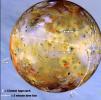Migrating Volcanic Plumes on Io
Caption:
This set of four images, taken by NASA's Galileo spacecraft, shows a sequence of volcanic activity on Jupiter's moon Io over the last two years. As seen from left to right, the feature called
Masubi
was observed during Galileo's 9th, 10th, 15th, and 22nd orbits of Jupiter. These images show that a plume deposit from Masubi appears in September 1997 and has disappeared eight months later, only to reappear in a different place little more than a year later. The deposit, which originated from a volcanic vent, contains snow rich in sulfur dioxide.
Plume deposits are formed when material is blown out of a vent in a continuous, geyser-like, high-velocity eruption, with the material then falling back to Io's surface under the influence of gravity. When it hits the surface, it forms a symmetric ring surrounding the plume vent. The plume deposits are transient features, present only while the associated plume is active and for a brief time afterwards. This sequence of images suggests that the plume deposit visible during Galileo's 10th orbit was almost completely gone by the time of its 15th orbit, eight months later. This illustrates how ephemeral the deposits are.
Scientists are intrigued by the speed at which the active plume location seems to have migrated. The distance between the centers of the deposits visible in the images from the 10th orbit, second from left, and 22nd orbit, the image on the right, (occurring over a period of less than two years), is about 125 kilometers (78 miles). The plume deposit has changed in size as well as location. The four arrows are the same size and orientation in the images from the 10th and 22nd orbit, showing that the dark ring of material is larger during the 22nd orbit than it was in the 10th orbit.
These images were taken through the violet filter of Galileo's camera. North is to the top and the Sun illuminates the surface from the left in the images from June 1997 and August 1999, and from the right in the images from September 1997 and May 1998. The images are centered at 50 degrees south latitude and 54 degrees west longitude and cover an area approximately 750 kilometers (470 miles) wide and 1,050 kilometers (660 miles) high. From left to right, the image resolutions are: 16 kilometers (10 miles), 10 kilometers (6.2 miles), 14 kilometers (8 miles), and, 16 kilometers (10 miles) per picture element.
From left to right, the images were taken by Galileo's camera on the following dates from the following distances from Io: June 17, 1997, at 816,500 kilometers (507,300 miles); September 18, 1997, at 1,046,500 kilometers (650,300 miles); May 30, 1998, at 1,398,500 kilometers (869,000 miles); and August 13, 1999, at 1,565,000 kilometers (972,400).

|
Click on this image to view
Galileo's flight plan for I24 & I25.
(MRPS95336)
|
|
Background Info:
The Jet Propulsion Laboratory, Pasadena, CA manages the Galileo mission for NASA's Office of Space Science, Washington, DC. JPL is a division of the California Institute of Technology, Pasadena, CA.
This image and other images and data received from Galileo are posted on the World Wide Web, on the Galileo mission home page at
http://solarsystem.nasa.gov/galileo/
. Background information and educational context for the images can be found at
http://www.jpl.nasa.gov/galileo/sepo
Cataloging Keywords:
| Name |
Value |
Additional Values |
| Target |
Io |
Jupiter |
| System |
Jupiter |
|
| Target Type |
Satellite |
Planet |
| Mission |
Galileo |
|
| Instrument Host |
Galileo Orbiter |
|
| Host Type |
Orbiter |
|
| Instrument |
Solid-State Imaging (SSI) |
|
| Detector |
|
|
| Extra Keywords |
Grayscale, Plume, Volcano |
| Acquisition Date |
|
| Release Date |
1999-10-08 |
| Date in Caption |
1997-06-17 |
1997-09-18, 1998-05-30, 1999-08-13 |
| Image Credit |
NASA/JPL/University of Arizona |
| Source |
photojournal.jpl.nasa.gov/catalog/PIA02503 |
| Identifier |
PIA02503 |

 Planetary Data System
Planetary Data System

